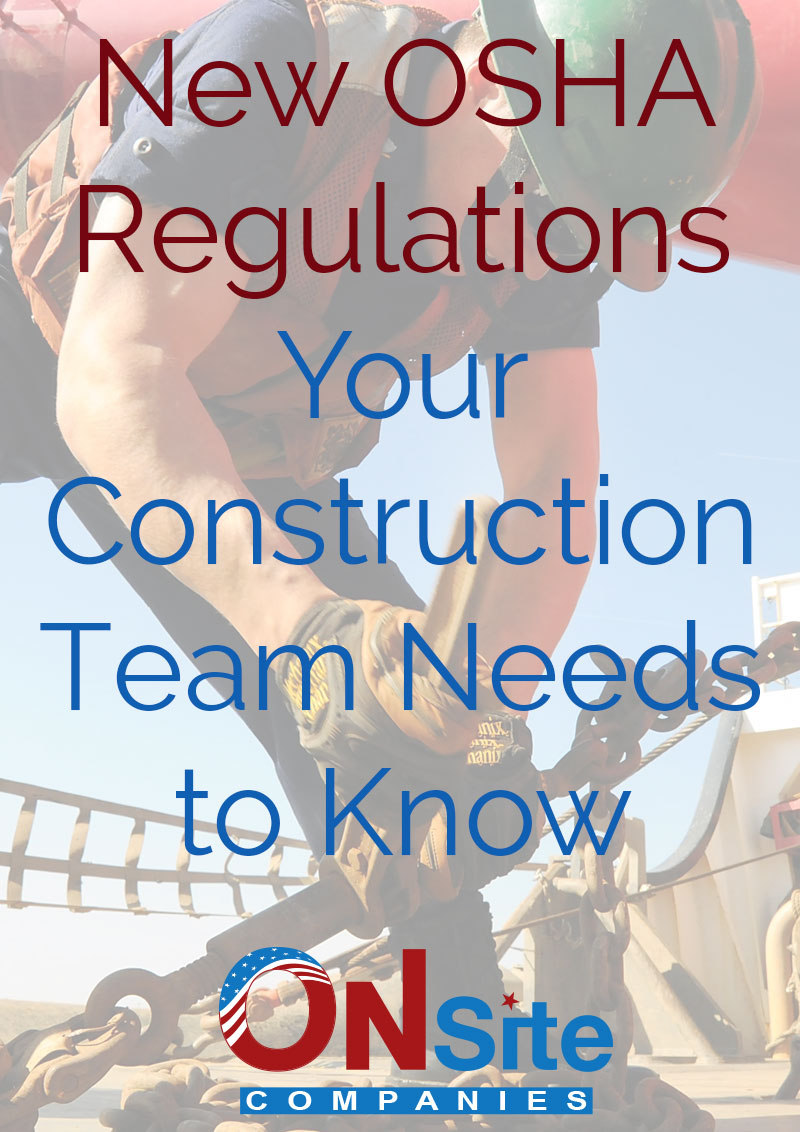Every year the Occupational Safety and Health Administration (OSHA) updates their rules and regulations. With new technologies and rapidly changing workforce demographics, there is a constant need to keep improving these rules and regulations in order to keep work environments safe, especially for construction sites.
While it is important to always keep in mind OSHA regulations to prevent workplace injury and avoid fines, we know it can be hard to keep up with the near constant implementation of new rules. We’ve created a list of some of the 2018 OSHA regulations that construction teams should look out for.

Occupational Exposure to Beryllium
Beryllium is a lightweight but extremely strong metal. It is commonly used for its electrical and thermal conductivity. Airborne beryllium inhaled by workers can result in Chronic Beryllium Disease (CBD) and even lung cancer. Although beryllium exposure covers a relatively small worker population, it is estimated that the final rule will help prevent 90 fatalities and 46 new cases of chronic illness each year.
The rule reduces the PEL for beryllium to 0.2 micrograms per cubic meter of air (µg/
m3) averaged over 8 hours, and establishes a short-term exposure limit (STEL) for beryllium of 2.0 µg/m3 over a 15-minute sampling period. OSHA proposed to revoke the ancillary provisions for the construction and the shipyard sectors that was adopted on Jan. 9, 2017, but retain the new lower permissible exposure limit (PEL) of 0.2 mg/m3 and the short-term exposure limit (STEL) of 2.0 mg/m3 for each sector.
To comply with these elements employers need to follow these rules:
- Limit access to high-exposure areas
- Provide respiratory protection and personal protective clothing
- Develop and implement written exposure control plans
- Offer medical examinations to certain exposed workers
Crane Operator Certification Extension
In August of 2010, OSHA established crane operator certifications as the sole criterion for operator safety. Following the publication of the final crane standard, stakeholders felt that certification did not by itself establish a safe enough level of experience and competence. Employers must be responsible to ensure that crane operators are qualified.
OSHA delayed the deadline for crane operator certification to Nov. 10, 2017. This gave them time to address these issues, but again the deadline was delayed. As of now, employers must comply with the requirements for crane operator certification and employer duty by Nov. 10, 2018.
OSHA’s rule offers four options to get certified:
- Certification by an independent testing organization accredited by a nationally recognized accrediting organization
- Qualification by an employer’s independently audited program
- Qualification by the U.S. military
- Compliance with qualifying state or local licensing requirements (mandatory when applicable)
With the use of this new regulation, employers will be able to employ more competent individuals in regards to crane and derrick operations.
Walking-Working Surfaces and Personal Fall Protection
OSHA is revising and updating its general industry standards on walking-working surfaces to prevent and reduce workplace injuries and fatalities. This rule is expected to prevent 29 fatalities and 5,842 lost-workday injuries each year.
The final rule for Walking-Working Surfaces and Personal Fall Protection consists of:
- Revised and new provisions addressing fixed ladders, rope descent systems, fall protection systems and criteria, and training on fall hazards, and fall protection systems
- Increased consistency between the general industry and construction standards
- Updated requirements to reflect advances in technology
While most of this rule came into effect in 2017, there’s a requirement on fixed ladders with a compliance date of Nov. 19, 2018. Existing fixed ladders installed before the compliance date, and newly fixed ladders installed after the compliance date, must be equipped with a personal fall arrest system, ladder safety system, cage, or well. This will allow employers time to get familiar with the new standards, evaluate necessary changes, purchase the necessary equipment, and develop and implement required training.
Electronic Submission of Injury and Illness Data
Another rule to be aware of in 2018 is the electronic submission of injury and illness data. The final rule requires employers in certain industries to electronically submit OSHA injury and illness data that employers are already required to keep under existing OSHA regulations. Establishments with 20-249 employees in certain high-risk industries must submit information from their 2017 Form 300A by July 1, 2018.
According to OSHA, this rule will improve safety for workers across the country. Having these records public will hopefully be able to steer employers in the right direction by focusing more on safety. In addition to requiring the electronic submission, the final rule includes provisions that prohibit employers from retaliating against workers for reporting a fatality, injury, or illness.
There are three ways to submit electronic data through a secure OSHA website:
- Users are able to manually enter data into a web form
- Users are able to upload a CSV file to process single or multiple establishments at the same time
- Users of automated recordkeeping systems will have the ability to transmit data electronically via an API (application programming interface)
Use High-Quality Equipment from On Site
Keeping up with new rules and regulations from OSHA can be difficult, but implementing best practices in safety and health is simple. On Site can provide your organization with an extensive selection of quality and affordable sanitation and climate control solutions, helping to make your construction site safer and more sanitary.
On Site can provide you with porta potty rentals, luxury bathroom trailers, and even shower trailers to provide a safe and clean environment suitable to industry best practices. Make sure your employees are breathing in quality air with air filtration, heating, and cooling systems, as well as dehumidifiers from On Site. For all of your sanitation and climate control needs, contact us today!